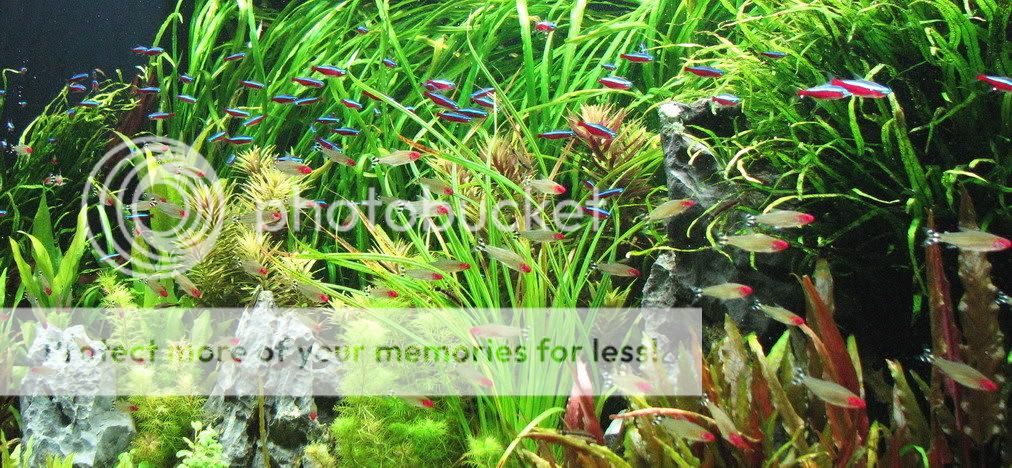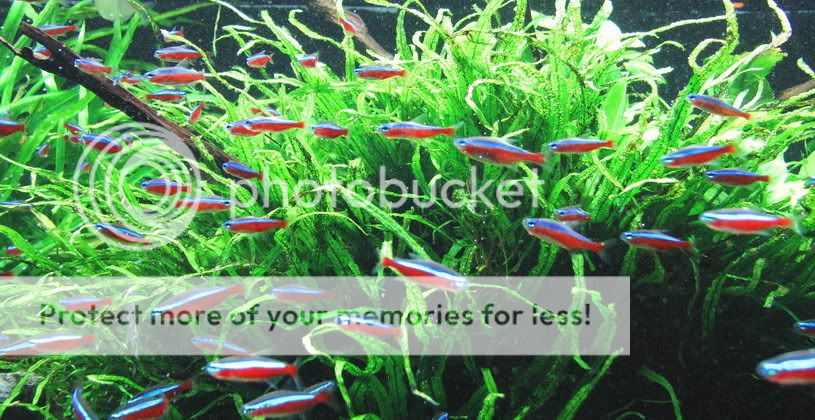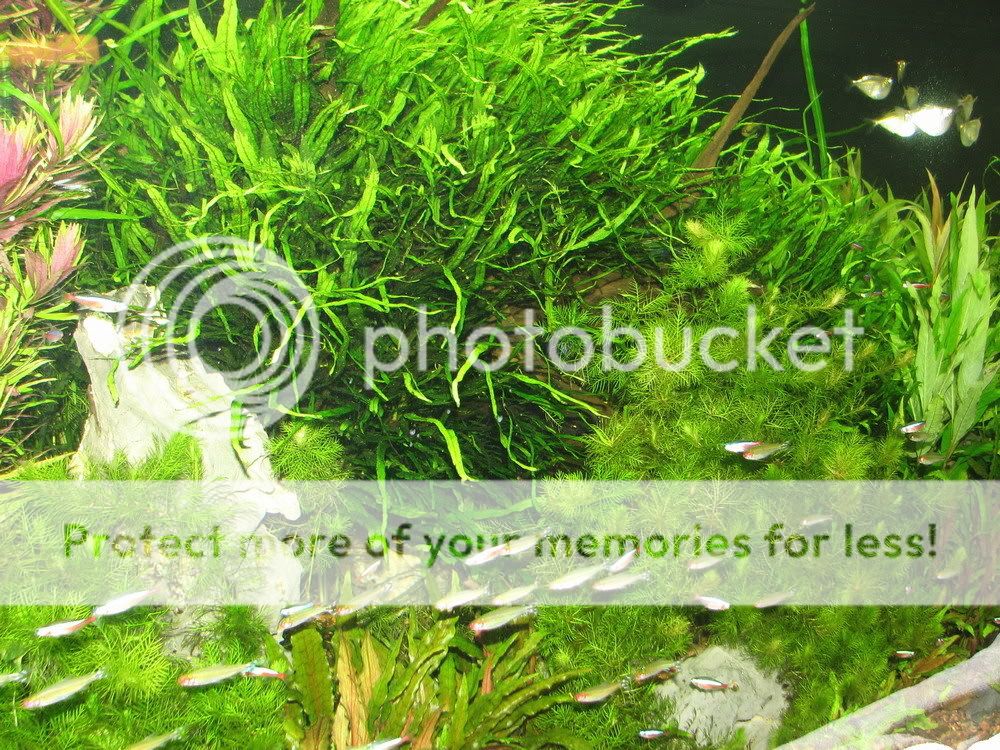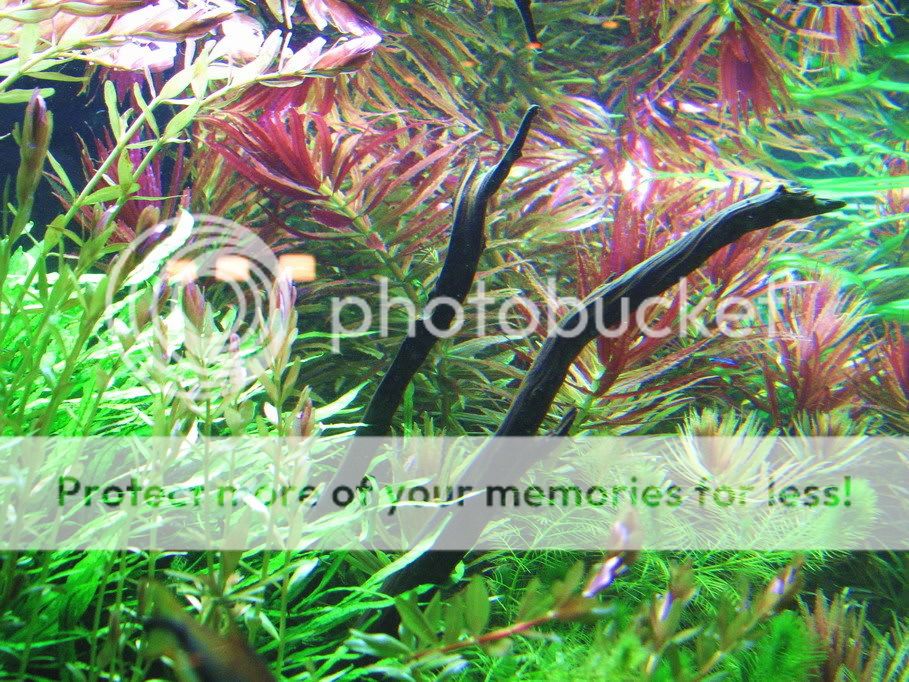plantbrain
Fishaholic
- Joined
- Aug 18, 2003
- Messages
- 476
- Reaction score
- 0
Well, some one asked, it's not like I have kept it a secret either:

Look at these sick fish after 3 years
Cardinals are suppose to be sensitive.

These come up and bite me

I spend 1.5 hours or so on the tank a week, that's it.
They dose 3x a week.
There's far more fish in here than you think.
There are several Apistos

Another 1/2 dead sickly fish after 3 years also?
Hummm.............
Here's one of the Acanthicus adonis, black statan plecos, this one is the runt, at 7", there are two that are about 10-12".
Not the best photo, but they always run and hide when I turn the lights on and I'm only there to service the tank and take a few snap shots.

I bought these little guys when they where about 1.5", little kittens.
I have P leopardus after 5-6", 4 Synodonits multipunctus, 3 Mango plecos, 4 gold spotted plecos, 2 Vampire plecos, 2 sribbled plecos. Gold dojos, N botia, otto cats(maybe 70), a few others running around in there.
All these fish have been exposed to standard high EI dosing and high feeding rates, high bioload for 3 full years.
No poor health, never disease, several eggs patches and breeding events took place, but the eggs get eaten.
Temp is 82F.
Easy tank to care for.
I am going to switch out the flourite and go with Flourite Black I think.
I'm not that happy with the scape, but the client prevented me from altering it and likes it this way.
So I'm slowly moving it around so there's not a dramatic shift.
I'll get a chance when I change the sediment over to really do a good redo.
Here's what it looked like 2 years ago:

Now this is recent.
And for a client.
What about other folks, like hobbyists?
Say a guy with less than a year in the hobby?
http /showcase.aquatic-gardeners.org/2003...vol=2&id=71
/showcase.aquatic-gardeners.org/2003...vol=2&id=71
James used EI.
So what can I say when folks bash EI and make cliams that it hurts their fish with excess levels of nutrients and other fear and doom claims?
Where's the evidence that this is true?
I ask because I am not seeing it even though after many years, I still have never had a disease, a sick fish, nor any deaths, I get good breeding results even though I'm no longer trying to breed fish. I use to do a lot of breeding until I started really focusing on plants, so I know fish very very well before even coming to plants seriously.
I like how some folks have claimed that a method killed their fish, heck CO2 kills fish too, folks do it all the time, that has nothing to do with dosing KNO3 though. Fish die in non planted tanks all the time for many unexplained reasons.
However, rather than trying to prove something here, I just have to prove what it is not, in this case EI = poor fish health.
If it was due solely to the dosing, then we should and would have to see and ngetaive effect on the fish, plants etc in these tanks if it was due to KNO3, NO3 etc as these hacks claim in their hypothesis.
What controls do they have and do they test their own hypothesis and questions?
I do and I can obviously produce a control tank that's in good shape with a good healthy plants and fish.
From there, you add more and more NO3 as KNO3 till you get a negative response.
The person dosing made a mistake and added 150ppm worth of KNO3 one week to this tank.
I said 15ppm.
They missed a decimal point!
So the fish and shrimp got exposed to 10x the dose.
I did not lose a single fish after 3-4 days.
I did lose 1/2 the Amano shrimp.
Since then, the plecos have eaten the remaining shrimp anyway.
Regards,
Tom Barr

Look at these sick fish after 3 years
Cardinals are suppose to be sensitive.

These come up and bite me

I spend 1.5 hours or so on the tank a week, that's it.
They dose 3x a week.
There's far more fish in here than you think.
There are several Apistos

Another 1/2 dead sickly fish after 3 years also?
Hummm.............
Here's one of the Acanthicus adonis, black statan plecos, this one is the runt, at 7", there are two that are about 10-12".
Not the best photo, but they always run and hide when I turn the lights on and I'm only there to service the tank and take a few snap shots.

I bought these little guys when they where about 1.5", little kittens.
I have P leopardus after 5-6", 4 Synodonits multipunctus, 3 Mango plecos, 4 gold spotted plecos, 2 Vampire plecos, 2 sribbled plecos. Gold dojos, N botia, otto cats(maybe 70), a few others running around in there.
All these fish have been exposed to standard high EI dosing and high feeding rates, high bioload for 3 full years.
No poor health, never disease, several eggs patches and breeding events took place, but the eggs get eaten.
Temp is 82F.
Easy tank to care for.
I am going to switch out the flourite and go with Flourite Black I think.
I'm not that happy with the scape, but the client prevented me from altering it and likes it this way.
So I'm slowly moving it around so there's not a dramatic shift.
I'll get a chance when I change the sediment over to really do a good redo.
Here's what it looked like 2 years ago:

Now this is recent.
And for a client.
What about other folks, like hobbyists?
Say a guy with less than a year in the hobby?
http
 /showcase.aquatic-gardeners.org/2003...vol=2&id=71
/showcase.aquatic-gardeners.org/2003...vol=2&id=71James used EI.
So what can I say when folks bash EI and make cliams that it hurts their fish with excess levels of nutrients and other fear and doom claims?
Where's the evidence that this is true?
I ask because I am not seeing it even though after many years, I still have never had a disease, a sick fish, nor any deaths, I get good breeding results even though I'm no longer trying to breed fish. I use to do a lot of breeding until I started really focusing on plants, so I know fish very very well before even coming to plants seriously.
I like how some folks have claimed that a method killed their fish, heck CO2 kills fish too, folks do it all the time, that has nothing to do with dosing KNO3 though. Fish die in non planted tanks all the time for many unexplained reasons.
However, rather than trying to prove something here, I just have to prove what it is not, in this case EI = poor fish health.
If it was due solely to the dosing, then we should and would have to see and ngetaive effect on the fish, plants etc in these tanks if it was due to KNO3, NO3 etc as these hacks claim in their hypothesis.
What controls do they have and do they test their own hypothesis and questions?
I do and I can obviously produce a control tank that's in good shape with a good healthy plants and fish.
From there, you add more and more NO3 as KNO3 till you get a negative response.
The person dosing made a mistake and added 150ppm worth of KNO3 one week to this tank.
I said 15ppm.
They missed a decimal point!
So the fish and shrimp got exposed to 10x the dose.
I did not lose a single fish after 3-4 days.
I did lose 1/2 the Amano shrimp.
Since then, the plecos have eaten the remaining shrimp anyway.
Regards,
Tom Barr

 x
x

